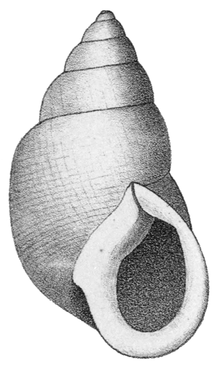Odontostomidae
| Odontostomidae | |
|---|---|

| |
| Drawing of the apertural view of a shell of Hyperaulax ridleyi. | |
| Scientific classification | |
| Domain: | Eukaryota |
| Kingdom: | Animalia |
| Phylum: | Mollusca |
| Class: | Gastropoda |
| Order: | Stylommatophora |
| Suborder: | Helicina |
| Superfamily: | Orthalicoidea |
| Family: | Odontostomidae Pilsbry & Vanatta, 1898 |
| Genera | |
|
See text | |
| Diversity[1] | |
| 125 species | |
| Synonyms[2][3] | |
| |
Odontostomidae is a taxonomic family of medium-sized to large, air-breathing, tropical and sub-tropical land snails, terrestrial pulmonate gastropod molluscs in the superfamily Orthalicoidea.[4][3]
Taxonomy
2005 taxonomy
This taxon was placed as the tribe Odontostomini, in the subfamily Bulimulinae, within the family Orthalicidae, according to the taxonomy of the Gastropoda (Bouchet & Rocroi, 2005).[2]
2010 taxonomy
Breure et al. (2010)[4] elevated Odontostomini to Odontostomidae.[4]
Genera
Genera in the family Odontostomidae include:
- Anostoma Fischer von Waldheim, 1807 - synonym: Ringicella Gray, 1847 cf.[5]
- Bahiensis Jousseaume, 1877[3][5]
- Biotocus Salgado & Leme, 1990[5]
- Bonnanius Jousseaume, 1900[5]
- Clessinia Doering, 1874[3][5]
- Cyclodontina Beck, 1837[3][5]
- Digerus Haas, 1937 cf.[6]
- Hyperaulax Pilsbry, 1897[5]
- Moricandia Pilsbry & Vanatta, 1898[5]
- Odontostomus Beck, 1837 - type genus of the tribe Odontostomini[2][5]
- Plagiodontes Doering, 1876[3][5]
- Spixia Pilsbry & Vanatta, 1898[3][5]
- Tomigerus Spix, 1827[5]
Description
Species in tribe Odontostomini have the aperture obstructed by internal lamellae, folds or teeth (rarely absent by degeneration); the base is perforate or has an umbilical suture; and the genitalia are extremely lengthened. Jaw either plaited or solid.[7][unreliable source?]
Odontostomini is clearly a natural group of genera, confined to South America east of the Andes, and with the exception of some species, south of the Amazon. That the whole series had its inception in a form in which the characteristic apertural teeth had already been developed, is demonstrated by the fact that these lamella and folds are clearly homologous throughout the species of the several genera. It follows from this that the toothless forms, such as Moricandia, are secondarily so, by degeneration of the teeth of their ancestors. Many species show the various stages of tooth degeneration.[7][unreliable source?]
References
This article incorporates public domain text from the reference[7]
- ^ Breure A., Groenenberg D. & Schilthuizen M. (2010). "Gondwana revisited: New insights in the phylogenetic relationships within the Orthalicoidea (Mollusca, Stylommatophora)". poster. PDF Archived 2012-03-09 at the Wayback Machine.
- ^ a b c Bouchet, Philippe; Rocroi, Jean-Pierre; Frýda, Jiri; Hausdorf, Bernard; Ponder, Winston; Valdés, Ángel & Warén, Anders (2005). "Classification and nomenclator of gastropod families". Malacologia. 47 (1–2). Hackenheim, Germany: ConchBooks: 1–397. ISBN 3-925919-72-4. ISSN 0076-2997.
- ^ a b c d e f g Breure A. S. H. & Romero P. (2012). "Support and surprises: molecular phylogeny of the land snail superfamily Orthalicoidea using a three-locus gene analysis with a divergence time analysis and ancestral area reconstruction (Gastropoda: Stylommatophora)". Archiv für Molluskenkunde: International Journal of Malacology 141(1): 1-20. doi:10.1127/arch.moll/1869-0963/141/001-020.
- ^ a b c Breure A. S. H., Groenenberg D. S. J. & Schilthuizen M. (2010). "New insights in the phylogenetic relations within the Orthalicoidea (Gastropoda, Stylommatophora) based on 28S sequence data". Basteria 74(1-3): 25-31.
- ^ a b c d e f g h i j k l Breure A. S. H. & Ablett J. D. (2012) "Annotated type catalogue of the Bothriembryontidae and Odontostomidae (Mollusca, Gastropoda, Orthalicoidea) in the Natural History Museum, London". ZooKeys 182: 1-70. doi:10.3897/zookeys.182.2720.
- ^ (in Portuguese) Norma Campos Salgado & Arnaldo C. dos Santos Coelho. (2003). "Moluscos terrestres do Brasil (Gastrópodes operculados ou não, exclusive Veronicellidae, Milacidae e Limacidae)" Archived 2011-10-04 at the Wayback Machine. Rev. Biol. Trop. 51(Suppl. 3): 149-189. (with English abstract)
- ^ a b c Pilsbry H. A. 1901. in Tryon G. W. & Pilsbry H. A. 1901-1902 - Oriental Bulimoid Helicidae. Odontostominae. Cerionidae Volume 14. Manual of Conchology. Second series: Pulmonata. page 24.
